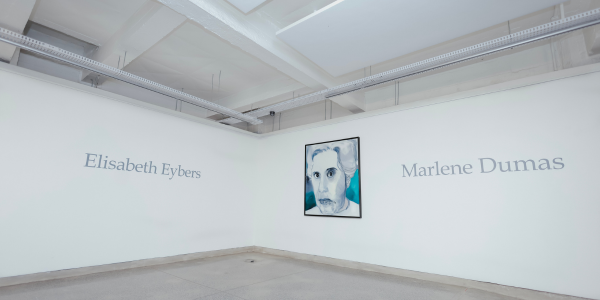A thousand words behind famous artist's portrait of a poet
- Wits University
World-renowned SA-born artist donates portrait of acclaimed Afrikaans poet and alumna to WAM.

Artist Marlene Dumas gifted her Portrait of Elisabeth Eybers to the Wits Art Museum in a donation brokered by author-academic Ena Jansen, an internationally recognised expert on Eybers and whose PhD from Wits was about the poet.
Dumas’s Portrait of Elisabeth Eybers was revealed at an intimate private gathering at WAM on Monday, 26 February.
The painting is on display at WAM for public viewing until 9 March 2024.
Included in the exhibition is a 20-minute purpose-made documentary film, featuring Dumas and Jansen, in which they discuss this painting and Eybers’ poetry.
Fiona Rankin-Smith, Special Projects Curator at WAM, said, “Every now and again in Johannesburg, it seems like the stars all align and it feels like this is the best city in the world. And tonight I feel is one of those nights.”
She expressed her gratitude that Dumas "considered Wits University to be a worthy recipient of this extraordinarily powerful work.”
“Not only are we able to view the painting here at WAM this evening, but we also have the artist herself present, along with Erna Jansen, author and academic, who has played such a role in the whole affair,” said Rankin-Smith. “As Ena has pointed out, today [26 February] is the anniversary of Eybers’ birth, so there’s a lot to celebrate.”
A distinguished homecoming
Emeritus Professor Gerrit Olivier, formerly Head of the Department of Afrikaans, Dean of the Faculty of Humanities, and Head of the Wits School of Arts at Wits University, introduced the artist, author, and poet.
“Not only is Wits receiving an exquisite painting from a much-celebrated South Africa artist, it is also lucky to have Marlene Dumas herself here, at an occasion which also is a symbolic homecoming of one of our most distinguished alumni, Elisabeth Eybers.
On top of that, we welcome an expert on Eybers’ poetry, Ena Jansen, who too is an alumna of Wits, having completed her PhD here, and she’s been a friend of both Dumas and Eybers for decades.”
Olivier said that Eybers wrote poetry about Johannesburg, and Dumas and Jansen soon realised that Joburg is the most appropriate place for the portrait to be – where Eybers was a student and where she lived for almost three decades. “So it’s a homecoming, in a way,” he said.
Olivier was also Jansen’s supervisor for her doctoral thesis on Eybers, awarded in 1992.
Understanding Eybers

Ena Jansen taught in the Department of Afrikaans and Nederlands at Wits for 16 years before it closed in the early 2000s.
Jansen is now an Extraordinary Professor of South African Literature at the University of Amsterdam, and the author of Afstand en verbintenis: Elisabeth Eybers in Amsterdam.
Jansen, Eybers and Dumas were all friends.
The poet in the portrait
Julia Charlton, Senior Curator at WAM, said, “This is an extraordinary painting, made even more special because it is a portrait of the South African-born poet Elisabeth Eybers, who was the first woman to publish in Afrikaans.”
Elizabeth Eybers Eybers (1915-2007) graduated from Wits in1937 with a BA Honours in Nederlands and Afrikaans.
She published her first collection of poetry, Belydenis in die Skemering, in 1936, her honours year.
Eybers was also the first Afrikaans woman to win the Hertzog Prize for poetry, in 1943, which she won again in 1971.
Wits University awarded her an honorary doctorate in 1972.
Two decades later, in 1991, Eybers received the P.C. Hooft Award, the Netherlands’ lifetime literary achievement award.
“It was the only time it was ever awarded to a non-Dutch writer,” said Olivier.
The artist behind the portrait
Eybers had moved to Amsterdam in 1963, which is where her portrait-painter, Marlene Dumas, is based.

In conversation with Jansen at the event, Dumas said that the “larger-than-life” portrait is “an abstract, psychosocial portrait” and revealed, “I don’t even know what colour her [Eybers’] eyes were.”
In explaining her process, Dumas said “painting happens on the canvas, not in sketches before.”
Dumas confessed to originally not being “such an Eybers fan” until she realised that the poet’s writing meant different things to what she, Dumas, had thought they meant.
Dumas conceded, “Eybers is OK. She is a much better poet than I thought.”
Of the Portrait of Elisabeth Eybers donation to WAM, Dumas remarked, “I’m very grateful that you want it.”
Portrait of Elisabeth Eybers
The Portrait of Elisabeth Eybers is a very large 130 x 110cm oil painting.
“It’s a portrait that remains with you once you have seen it and we are seeing it tonight exactly 109 years after Eybers was born,” said Olivier.
The portrait was retrospectively exhibited at the Standard Bank Gallery in 2008 and Intimate Relations is the catalogue for that show. Eybers’ poems were included in the catalogue.
Eybers’ poem Geluk (‘happiness’), in both Afrikaans and translated by the poet herself into English, are on display at WAM alongside the portrait.
‘To reveal, not to display’
“[The portrait] captures the intensity and piercing intelligence of Eybers’ presence as I remember it from a couple of meetings with her … It’s a look at the vulnerable self in detachment,” said Olivier, and, quoting Dumas, added, “The painter’s insistence that the painting is ontologically different of other order of art forms. It is the result of the painter’s engagement with form, not of any pre-conceived notion. It avoids storytelling, it discards irrelevant information. It combines intimacy, or the illusion of that, with discomfit. The aim is to reveal not to display.”

